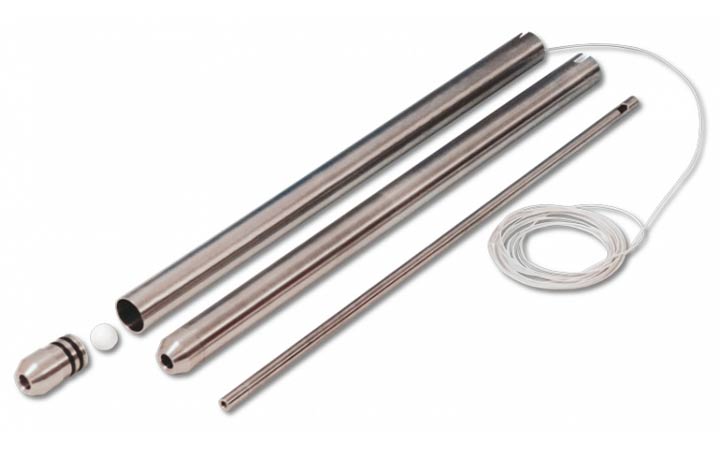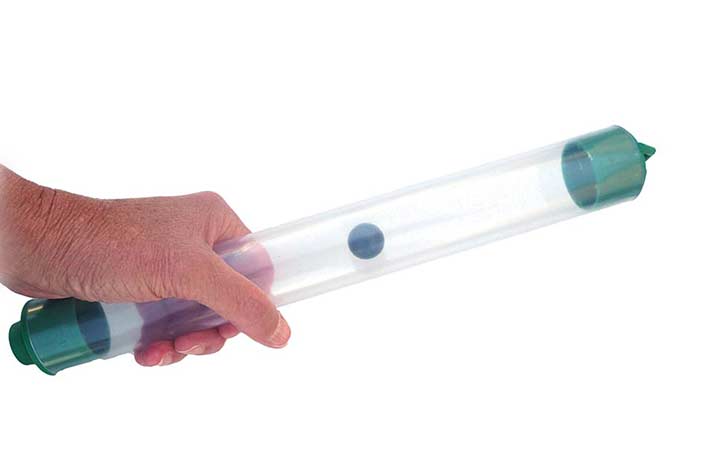- Simple and Cost Effective No expensive ancillary equipment is needed
- Range of Lengths and Diameters 0.5, 1, 1.5 and 2 inch diameters and standard lengths of 2, 3 and 4 ft available
- Ideal for aquifer profiling
- Stainless Steel Construction
Overview
Point-source sampling collects water as it flows into the desired sampling point, which prevents purging and the disposal of purged water. Because of this, point-source sampling is perfect for obtaining high-quality groundwater samples from specific depths.
Often used to profile open boreholes and screened wells, the 429 Point Source Bailer collects samples from specific levels and inflow points. The mixing of water from different levels is prevented reducing sample contamination to minimal levels. Ancillary equipment is not required, making point-source sampling in hard-to-access locations more manageable. With a diameter of only 0.5” (12.7 mm), the miniature model is suitable for direct-push devices and narrow tubes.
Method of Operation
While the bailer is slowly lowered on a support line to the depth of the desired source, both ball valves open, allowing water to flow through the sampler. Once the desired sample depth is reached, the bailer is raised in a steady, controlled manner. The upward momentum and water weight keep the ball valves closed, and the ball valve located on the top of the bailer prevents the sample from mixing with water in higher levels. The bottom valve prevents the sample from leaking out of the bailer. When the bailer reaches the surface, the top vent is opened allowing sample material to drain into a container. Before taking another sample the bailer should be decontaminated.
The 429 Point Source Bailer consists of well-built components made from high-quality materials, including 316 stainless steel with PTFE/FEP ball valves and Viton O-rings. The sampler is supplied with a sample-release device made from stainless steel. This minimises the loss of materials that can occur during the transfer between the bailer and the sample container.
For use with the 429 Point Source Bailer, the Solinst Model 103 Tag Line is recommended. It's mounted on an easy-to-use reel, and includes marks at either 1 ft or 5 ft intervals (0.5 m or 1 m).
Manufactured by: Solinst
Model: Solinst 429 Point Source Bailer
Services offered for this product
- Sales
- Rental
- Installation
- Calibration
- Maintenance
Applications
Borehole profiling
Well monitoring
Point sampling
Specification
| Bailer Capacity | |||
|---|---|---|---|
| O.D. inch | Capacity oz | O.D. mm | Capacity ml |
| 2 ft Length (610 mm) | |||
| 0.5 | 1.7 | 12.7 | 50 |
| 1.0 | 7 | 25.4 | 210 |
| 1.5 | 13 | 38.1 | 390 |
| 2.0 | 29 | 50.8 | 850 |
| 3 ft Length (910 mm) | |||
| 0.5 | 2.7 | 12.7 | 80 |
| 1.0 | 11 | 25.4 | 330 |
| 1.5 | 23 | 38.1 | 680 |
| 2.0 | 47 | 50.8 | 1390 |
| 4 ft Length (1220 mm) | |||
| 0.5 | 3.7 | 12.7 | 110 |
| 1.0 | 15 | 25.4 | 450 |
| 1.5 | 33 | 38.1 | 970 |
| 2.0 | 65 | 50.8 | 1930 |
| Point Source Bailers come in standard lengths of 2ft. (610 mm), 3 ft. (910 mm), or 4 ft. (1220 mm) | |||
Downloads
Related products
FAQ's
- Lower cost for instrumentation
- Faster sampling
- Little/no water agitation
- Simple
- Allows sampling in wells with small water volumes
- Variety of sample sizes
- Can be used to identify stratified layers of water chemistry in wells/boreholes




